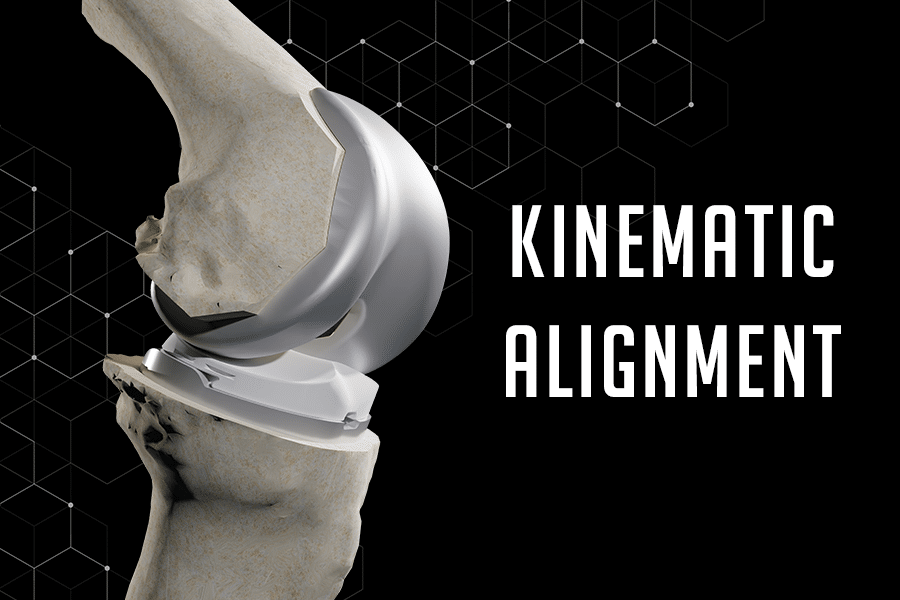What does the literature say? – An Overview
The impact of alignment on prosthesis longevity and postoperative performance in total knee arthroplasty cannot be overstated1. Proper knee alignment restoration decreases mechanical, and shear loads on the polyethylene (PE) insert and the interfaces between the bone and the prosthesis. The restoration of a neutral mechanical axis in the lower extremity, with the femoral and tibial components aligned perpendicular to the mechanical axis in the coronal plane, is thought to be necessary for a good outcome. Even though mechanical alignment (MA) is the most often used surgical technique in TKA for restoring patient function, 15 to 25% of patients have reported unhappiness, with 10% requiring revision surgery within ten years of the procedure2.
Kinematic alignment in total knee arthroplasty is a surgical technique that involves aligning the prosthetic knee joint to mimic the natural movement and alignment of the patient’s uninjured knee3. This technique differs from traditional mechanical alignment, which involves aligning the prosthetic joint based on geometric measurements and mechanical principles rather than the patient’s individual kinematics.
One potential benefit of kinematic alignment, as listed in research published in 2020, is that it may reduce the contact pressure on the polyethylene (PE) component of the prosthetic joint4, which is a type of plastic material that is commonly used in total knee arthroplasty. High contact pressures on the PE component can lead to increased wear and joint failure. By aligning the prosthetic joint to match the natural movement and alignment of the patient’s uninjured knee, kinematic alignment may reduce the contact pressure on the PE component by increasing the contact area.
In a study published in 2019, researchers compared the contact pressure on the PE component of kinematically aligned and mechanically aligned prosthetic joints in cadaveric knees. They found that the kinematically aligned joints had significantly lower contact pressures on the PE component than the mechanically aligned joints5.
Another study, published in the Journal of Knee Surgery in 2019, observed the near normal gait in patients with kinetic alignment when undergoing total knee arthroplasty. The researchers found that the kinematically aligned joints had closer to the native joint line when compared with the ones mechanically aligned. This near-normal joint line is presumably responsible for these people’s relatively normal gait, as seen while analyzing the gait cycle6.
In addition to potentially reducing contact pressure on the PE component, kinematic alignment may offer other potential benefits in total knee arthroplasty. Some studies have suggested that kinematic alignment may be able to improve the stability and function of the prosthetic joint, which could lead to better patient outcomes. Other research has suggested that kinematic alignment may reduce the risk of complications such as implant loosening and instability, which are common issues in total knee arthroplasty. Not only this, but the kinematic alignment also restores the normal alignment of the lower extremity and prevents the imbalance of collateral ligaments, thus providing more physiological forces exerted on the collateral ligaments than mechanical alignment7.
Despite the potential benefits of kinematic alignment, it is essential to note that this surgical technique is not without its challenges. One issue is that it requires a high level of skill and expertise to properly align the prosthetic joint using this technique, making it more challenging to perform than mechanical alignment. In addition, kinematic alignment may be more time-consuming and require specialized equipment, which can increase the cost of the surgical procedure.
Overall, the evidence suggests that kinematic alignment in total knee arthroplasty may reduce contact pressure on the PE component of the prosthetic joint by increasing the contact area. This may improve the prosthetic joint’s stability and function and reduce the risk of complications. However, most of these studies are retrospective and long-term data is not as readily available. The meta-analysis has shown better outcomes with kinematic alignment, but the results do not have a significant p-value prompting further research.
If you believe in the benefits of kinematic alignment, then Kinomatic can help you achieve these results. Our approach to, not only knee replacements but all joint replacements, is to deliver a completely customized procedure to not only best fit the patient’s natural anatomy but also to match our surgeon’s preferred techniques. We do this through CT imaging, 3D surgical planning, and virtual reality simulations. If you would like to learn more about Kinomatic or would like to get an appointment with one of our Kinomatic Certified Physicians, head to our website, www.kinomatic.com.
